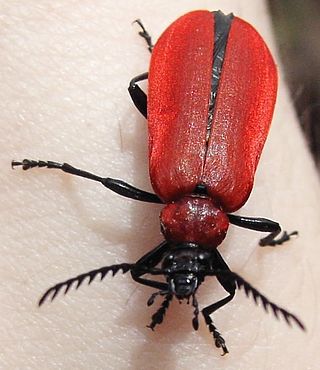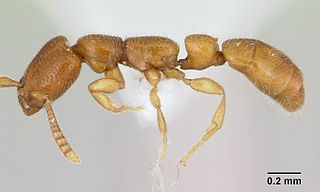
Fire-coloured beetles is the common name for members of the tenebrionoid family Pyrochroidae. The family is found worldwide, and is most diverse at temperate latitudes. Adults measure 2–20 millimetres (0.079–0.787 in); larvae reach 35 millimetres (1.4 in). Larvae of Pyrochroinae are found associated with the bark of dead trees. They are probably mostly fungivorous, although they may become cannibalistic if too crowded.

The Ochteridae comprise a small family of insects. Eight genera with about 80 species have been described. They occur worldwide along the shore of various types of water and the greatest diversity is in tropical regions. They are "true bugs", being members of the order Hemiptera, and are in the suborder Heteroptera. Ochteridae commonly are known as the velvety shore bugs. They resemble the Saldidae shore bugs and have lengths ranging from 4.5 to 9 mm (0.18–0.35 in).
Utricularia stygia, the arctic bladderwort or Northern bladderwort, is an affixed aquatic carnivorous plant that belongs to the genus Utricularia. U. stygia is native to northern Europe and North America. This species was originally published by Göran Thor in 1987 but the description was not in Latin and was therefore nomenclaturally invalid. Thor validly published the species a year later. The cited difference that separates U. stygia from U. ochroleuca is the shape of the tiny quadrifid glands inside the bladders, specifically at which angle the "arms" of these glands diverge from one another. Thor, when working on the Utricularia of Sweden noted that this distinction alone allowed for consistent species identification. Both Barry Rice and Peter Taylor have expressed concerns regarding how this method applies to other populations around the world.

Apomyrma stygia is a species of ant found in West Africa, first described in 1970. It is the only species in the genus Apomyrma, tribe Apomyrmini, and subfamily Apomyrminae. It has been suggested the ant primarily lives in tropical forests, and apparently belongs to a guild of centipede-feeding ants.

Catephia is a genus of moths of the family Erebidae. Most species of this genus are found in Africa.
Colotis daira, the black-marked orange tip, is a butterfly in the family Pieridae. It is found in the Nigeria, Sudan, Ethiopia, Somalia, Saudi Arabia, Yemen, Oman, Kenya and Tanzania. The habitat consists of dry savanna.

Junonia stygia, the brown pansy, dark pansy or Aurivillius' brown pansy, is a butterfly in the family Nymphalidae. It is found in Senegal, Guinea-Bissau, Guinea, Sierra Leone, Liberia, Ivory Coast, Ghana, Togo, Nigeria, Cameroon, Gabon, the Republic of the Congo, the Central African Republic, Angola and the Democratic Republic of the Congo. The habitat consists of forests, including disturbed areas and secondary forests.

Calliphora stygia, commonly known as the brown blowfly, or rango tumaro in Māori, is a species of blow-fly that is found in Australia and New Zealand. The brown blowfly has a grey thorax and yellow-brown abdomen.
Baliochila stygia is a butterfly in the family Lycaenidae. It is found along the coast of Kenya and in Tanzania. Its habitat consists of coastal forests.

Stygia australis is a species of moth of the family Cossidae. It is found in France, Italy, Portugal and Spain. "This species is common in Southern Europe. It expands about an inch. The head and thorax are brownish-yellow, and so are the antennae. The abdomen is elongated, blue-black in colour with a small anal tuft. The fore-wings are narrow, brownish in the male, with greyish-white markings, and the hind-wings are rounded, blue-black, with a large white spot in the centre. In the female the fore-wings are reddish-yellow, varied with brownish, and the hind-wings are coloured as in the male. The larva, which is smooth and whitish, with the head and thoracic segments yellowish, lives in the roots and stalks of Echium italicum". Now it is very little known.
Stygia hades is a species of moth of the family Cossidae. It is found on the Canary Islands, as well as in North Africa, including Morocco.
Stygia mosulensis is a species of moth of the family Cossidae. It is found in Bulgaria and Greece, as well as in Iraq and Iran.
Stygia nilssoni is a species of moth of the family Cossidae. It is found on the Canary Islands.
Stygia is a genus of moths belonging to the family Cossidae.

iNaturalist is an American 501(c)(3) nonprofit social network of naturalists, citizen scientists, and biologists built on the concept of mapping and sharing observations of biodiversity across the globe. iNaturalist may be accessed via its website or from its mobile applications. iNaturalist includes an automated species identification tool, and users further assist each other in identifying organisms from photographs and even sound recordings. As of 9 July 2024, iNaturalist users had contributed approximately 197,660,888 observations of plants, animals, fungi, and other organisms worldwide, and 290,007 users were active in the previous 30 days.

Laphriinae is a subfamily of robber flies in the family Asilidae. There are more than 110 genera and 1,000 described species in Laphriinae. Many are mimics of syntopic bees. Some prey on bees as adults. Larvae of the genus Hyperechia are known to grow inside the cells of Xylocopa bees, feeding on their larvae.
Catephia stygia is a species of moth of the family Erebidae. It is found in western China.

Laphriini is a tribe of robber flies in the family Asilidae. There are about 7 genera and at least 80 described species in Laphriini.

Orthogonis is a genus of robber flies. There are about 14 described species in Orthogonis.
Sugia stygia is a moth of the family Noctuidae first described by Arthur Gardiner Butler in 1878. It is found in Japan, Korea, India, Sri Lanka, Taiwan and China.











